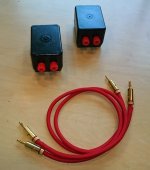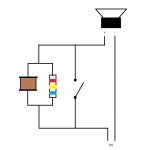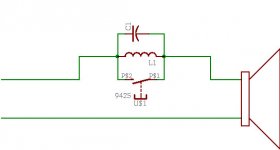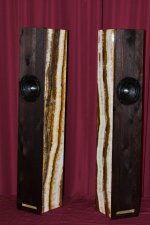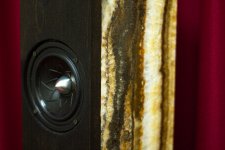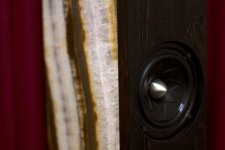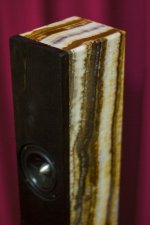Yes,
keep the BSC outside your TABAQs until you are happy with it. Then, just unscrew the plate connectors (if you have one) and put it inside the speakers.
Get a few resistors to try. 8, 6.8, 5, 3 ohms... pick the one to your liking.
keep the BSC outside your TABAQs until you are happy with it. Then, just unscrew the plate connectors (if you have one) and put it inside the speakers.
Get a few resistors to try. 8, 6.8, 5, 3 ohms... pick the one to your liking.
Hi Harry
The resistor and coil that make up a BSC are in parallel with each other but are wired together in series with one of the two wires that go out to each speaker. As a result you only need one SPST switch (rated for a couple amps) for each speaker to short out the BSC and effectively remove it from the circuit.
One leg of the switch goes to where one incoming wire is soldered (or otherwise connected) to one leg of the resistor and coil and the other leg of the switch goes to the other side of the components where they are soldered to the wire that continues on to the speaker.
When the switch is open ('off' position for the switch itself) the current flows through the resistor and coil. When the switch is closed ('on') the current flows through the switch contacts, effectively making it like the BSC isn't even there.
Michael
The resistor and coil that make up a BSC are in parallel with each other but are wired together in series with one of the two wires that go out to each speaker. As a result you only need one SPST switch (rated for a couple amps) for each speaker to short out the BSC and effectively remove it from the circuit.
One leg of the switch goes to where one incoming wire is soldered (or otherwise connected) to one leg of the resistor and coil and the other leg of the switch goes to the other side of the components where they are soldered to the wire that continues on to the speaker.
When the switch is open ('off' position for the switch itself) the current flows through the resistor and coil. When the switch is closed ('on') the current flows through the switch contacts, effectively making it like the BSC isn't even there.
Michael
How about using a SPDT switch instead?
One side is straight to the speaker, the other has the BSC. This way, the BSC is not active at the same time the straight bypass is.

One side is straight to the speaker, the other has the BSC. This way, the BSC is not active at the same time the straight bypass is.

Michael,
I have translated your description to a scheme. Is this what you meant?
Thnx
Harry
Harry: Yep, that's exactly how mine is done.
GM: I hate switching any inductively loaded circuit so I'm sure I'd at least turn down the volume first. That said, which amp types do you think would have a problem with the ~3msec switching transient implied in Perceval's approach?
I know about the ringing output issues with some 3116 based amps and the output transformers on certain classes of tube amps but I hadn't heard they'd have issues with that short a transient 'open'. Are there others I should watch out for?
M
Second option is better as it shorts the BSC while keeping load on the amp. This should also not cause a pop on the speakers! You could use this design on a SPST (or one side of a SPDT if thats available.)
Just need a little cleanup, and these will be done.
The enclosure is onyx stone, with a wood baffle. About 12kg each.
Will need to take better pictures as they look even better than this in real life.
Close ups of the crystal-like onyx stone. Just beautiful.
The bass is so tight. Much better than my all wood TABAQs.
The enclosure is onyx stone, with a wood baffle. About 12kg each.
Will need to take better pictures as they look even better than this in real life.
Close ups of the crystal-like onyx stone. Just beautiful.
The bass is so tight. Much better than my all wood TABAQs.
Attachments
Looking for clarifications
You just said that you have a two transmission lines - one made of wood and the other with (some) stone and you are saying that the bass is much tighter with stone? can you give more details - weight of the wooden enclosure (presuming they are identical) compared to the one with stone, thickness of the material used in both construction, and if the drivers / vents are placed at the same height? presuming they are tested in the same room and position in the room.
I am looking for this answer for a long time - how much does a TL gain if you use proper building materials (not wood) - because the internal pressure suppose to be very small so enclosure material is less important.
Just need a little cleanup, and these will be done.
The enclosure is onyx stone, with a wood baffle. About 12kg each.
Will need to take better pictures as they look even better than this in real life.
Close ups of the crystal-like onyx stone. Just beautiful.
The bass is so tight. Much better than my all wood TABAQs.
You just said that you have a two transmission lines - one made of wood and the other with (some) stone and you are saying that the bass is much tighter with stone? can you give more details - weight of the wooden enclosure (presuming they are identical) compared to the one with stone, thickness of the material used in both construction, and if the drivers / vents are placed at the same height? presuming they are tested in the same room and position in the room.
I am looking for this answer for a long time - how much does a TL gain if you use proper building materials (not wood) - because the internal pressure suppose to be very small so enclosure material is less important.
I have one set made of lightweight wood, maybe 2kg each. This last set has a stone "veneer" of 6mm over a 8mm plywood. Same room, I do feel the bass has more punch.
Your stone versions look interesting.Im wondering though what amp your using and the watts your feeding to your TL's? And are you using the same driver in each version (stone and wood)?
Perceval,
Nice job with the speakers!
Same drivers you are using for the lightweight wood TABAQ's?
Nice job with the speakers!
Same drivers you are using for the lightweight wood TABAQ's?
2 kg/enclosure of this size is very lightweight, this would not be a good comparison to a stone enclosure - so there must be losses in rigidity or something; I would expect weight to be 5-7.5 kg for wooden enclosure.I have one set made of lightweight wood, maybe 2kg each. This last set has a stone "veneer" of 6mm over a 8mm plywood. Same room, I do feel the bass has more punch.
The combination wood + stone should be good enough ans safe from cracking; the easiest way to build is with glass - cheap and easy to get. Glass has a density of 2.4 kg/liter (or higher) so it's almost as heavy as aluminium.
Man, now I'm going to feel really lame when pix of mine go up ;-)
Perceval: Those are the 4 in. TB's yes?
Did you adjust any interior dimensions/stuffing with this build?
Do they measure any different?
Nice job!
M
Perceval: Those are the 4 in. TB's yes?
Did you adjust any interior dimensions/stuffing with this build?
Do they measure any different?
Nice job!
M
Thanks to all the kind words.
Yes, those are the TB W4-1052SD.
Dimensions are the same, I didn't alter the vent to the new style. There is 80g of pillow stuffing inside.
I have fed these (and the wooden ones) with different amps. The little TPA3116 (50W), a Yamaha receiver (90W) and a NuPrime amp (200W). The worst sounding being the TPA3116.
Latest round of tests were with the Yamaha receiver, set in direct stereo, and connected to a USB DAC. A little boost at 150Hz, and a little notch at 3500Hz. They also can barely reach 15kHz, but after that, there's not much.
MichaelEve, don't worry! 🙂 Just build them, and post. It's not a contest, it's an appreciation of Bjørn's design!
Yes, those are the TB W4-1052SD.
Dimensions are the same, I didn't alter the vent to the new style. There is 80g of pillow stuffing inside.
I have fed these (and the wooden ones) with different amps. The little TPA3116 (50W), a Yamaha receiver (90W) and a NuPrime amp (200W). The worst sounding being the TPA3116.
Latest round of tests were with the Yamaha receiver, set in direct stereo, and connected to a USB DAC. A little boost at 150Hz, and a little notch at 3500Hz. They also can barely reach 15kHz, but after that, there's not much.
MichaelEve, don't worry! 🙂 Just build them, and post. It's not a contest, it's an appreciation of Bjørn's design!
- Home
- Loudspeakers
- Full Range
- TABAQ TL for Tangband
